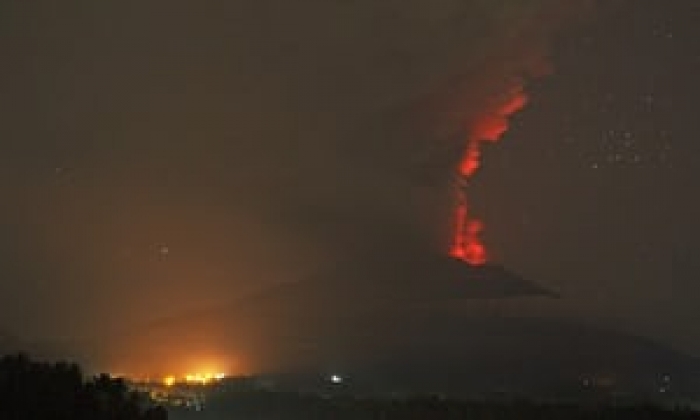“We could see the magma tonight,” Nyoman Karyiarsa, a resident of Rendang village, told the Guardian on Monday evening. “From 7pm to 8pm, we could see a bright red colour from the crater, but it hasn’t come out yet.”
The Rendang monitoring post registered powerful and continuous tremors at about 2pm on Tuesday in Bali, with locals and journalists told to evacuate. The last big eruption in 1963 was preceded by continuous tremors.
The Balinese volcano, the highest point on the island, has grown increasingly restless over the past week, with the alert system raised to its highest level early on Monday, as the nature of the eruptions has shifted from phreatic, or steam-based, to magmatic.
About 100,000 people in 22 villages within a six-mile red zone around the volcano have been told to leave immediately.
Karyiarsa said refugees from the mountains were continuing to flee to his village and he had felt several slight tremors over recent days. “We are just outside the red zone but we can hear the rumbling of the mountain, and ash is covering the leaves. If you don’t wear a mask you can feel it when you breathe,” he said.
Photos of Mount Agung at daybreak on Tuesday showed a dramatic two-tone column of ash rising from the volcano. Disaster agency spokesperson Sutopo Purwo Nugroho said on Twitter that the white column derived from water vapour, while the dark grey was produced by magma.
Volcanologists warn that the main hazards of a large eruption are hot and fast-moving avalanches of rocks, dust and gas that cannot be outrun, known as pyroclastic flows, as well as mudflows and ashfall.
In the current rainy season authorities have stressed the dangers of hazardous ash and rapid-moving mudflows known as lahar, which collect rocks, ash and debris that result in thick tides resembling wet concrete.
The continued eruption of Mount Agung has disrupted the plans of thousands of travellers. Volcanic ash can affect planes’ engines so Bali airport was closed on Monday and has not yet reopened. Officials are evaluating conditions every six hours.
Ash is falling predominately in a south-west direction, Indonesia’s disaster agency said on Tuesday, and is also being affected by the movement of tropical cyclone Cempaka off the coast of Java.
Instruments to measure activity at Mount Agung were installed only after the last big eruption in 1963, making it difficult for volcanologists to compare historical data and predict the intensity of future eruptions.
More about: #Bali















































